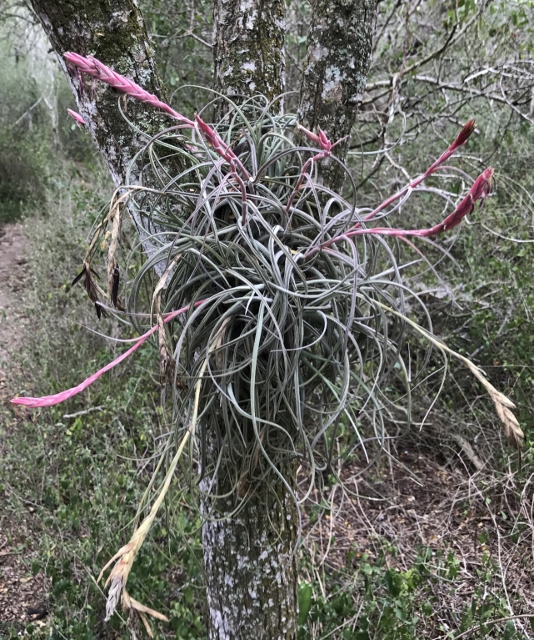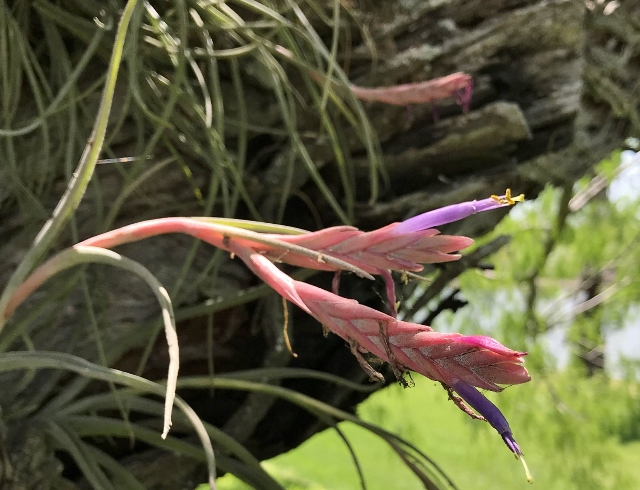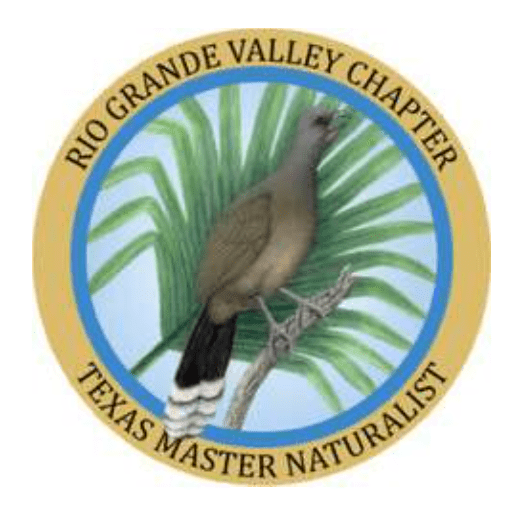
Rescued rare native plants can thrive in cultivation
By Anita Westervelt, Texas Master Naturalist
Bailey’s ball moss is one of those dream plants that absolutely takes care of itself. It’s so self-sufficient it can be tossed into the crook of a tree and forgotten.
The scientific name for Bailey’s ball moss is Tillandsia baileyi. The plant belongs to the Bromeliaceae family.
Bailey’s ball moss is an epiphyte, which is a plant that grows upon another plant but does not draw food nor water from the host plant.
In contrast, a parasite, like mistletoe, obtains its food or water partly from its host — typically a tree branch — and uses the sap from the branch, eventually harming the host plant.
The favored host for Bailey’s ball moss is a branch of a Texas ebony. Bailey’s ball moss can be just as happy lodged in a fork of a mesquite.
Where there’s one, there’ll be many, eventually; its habit is to grow in clumps, although it is a slow-growing plant.
An epiphyte is sometimes referred to as an air plant. Convention has it that it gets nutrients from the air. In fact, it does; it gets moisture from mist, fog and humidity. Dust from the air, leaves dropping from the tree and landing in the ball and rotting, leaves and other detritus blown into its mass by the wind, all break down into useful nutrients that feed the plant.
In spring, yellow stamen protrude from cylindrical lavender flowers that peak out of the basket-like weave at the tips of the bloom stalk. Hummingbirds draw nectar from the flowers.

Bailey’s ball moss is native in the Lower Rio Grande Valley and considered rare. Large clumps, more than a foot in diameter, have been found in native trees growing along the Arroyo Colorado in old growth forests.
Mesquite branches that have died for one reason or another and fallen to the ground can sometimes be stumbled upon with clusters of Bailey’s ball moss clinging to the limb. In addition, bunches of ball moss are often dislodged from their host tree by wind and can be rescued and placed in an ebony or mesquite of the finder’s choice. Bailey’s ball moss has been known to thrive under cultivation such as that.
Found bunches of the plant can be discretely tied with string or thin wire onto their new host tree branch. Anytime rare habitat can be rescued and relocated to other parts of the Valley, with the intention to preserve and promote the species, is a bonus for our native habitat.
Another native epiphyte is called simply ball moss, Tillandsia recurvata. The leaves are the same gray-green of Bailey’s ball moss, but ball moss is more petite in size and has a tighter ball growth. Like the Bailey’s, it is not a true moss as mosses do not produce flowers. Ball moss flowers are nearly insignificant, white, wispy little tufts that stick out from the ball.
Seeds of both Bailey’s ball moss and ball moss are blown by the wind. Moderate populations of ball moss are not harmful to healthy trees.
